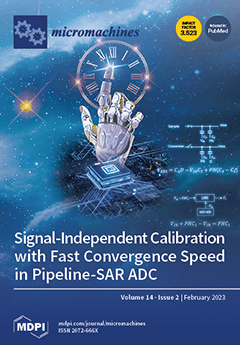Tunable structural colors have a multitude of applications in the beautification of mobile devices, in the decoration of artwork, and in the creation of color filters. In this paper, we describe a Metal-Insulator-Metal (MIM) design that can be used to systematically tune structural
[...] Read more.
Tunable structural colors have a multitude of applications in the beautification of mobile devices, in the decoration of artwork, and in the creation of color filters. In this paper, we describe a Metal-Insulator-Metal (MIM) design that can be used to systematically tune structural colors by altering the thickness of the top metal and intermediate insulator. Cu and Si
3N
4 were selected as the top metal and intermediate insulator layers, respectively, and various reflection colors were printed on Al. To protect the Cu surface from scratchiness and oxidation, a number of capping layers, including SiO
2, LPSQ, PMMA, and the commercially available clear coat ProtectaClear, were applied. In addition to their ability to protect Cu from a humid environment without deteriorating color quality, ProtectaClear and LPSQ coatings have minimal angle dependency. Furthermore, a bilayer of PMMA/SiO
2 can protect the Cu surface from the effects of humidity. In addition, the PMMA/SiO
2 and ProtectaClear/SiO
2 bilayers can also protect against corrosion on the Cu surface. The colors can be tuned by controlling the thickness of either the metal layer or intermediate insulator layer, and vivid structural colors including brown, dark orange, blue, violet, magenta, cyan, green-yellow, and yellow colors can be printed. The measured dielectric functions of Cu thin films do not provide any evidence of the plasmonic effect, and therefore, it is expected that the obtained colors are attributed to thin-film interference.
Full article






